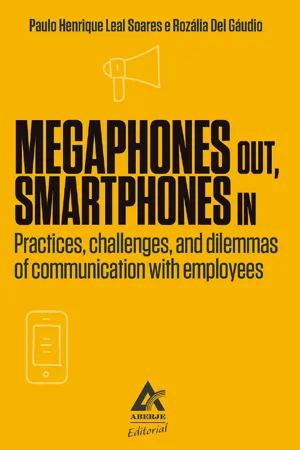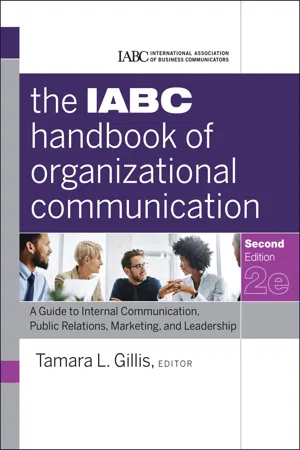Business
Internal and External Communication
Internal communication refers to the exchange of information within an organization, involving interactions between employees, departments, and management. It is crucial for sharing company goals, policies, and updates. External communication, on the other hand, involves interactions with individuals or entities outside the organization, such as customers, suppliers, and the public. This includes marketing, public relations, and customer service efforts.
Written by Perlego with AI-assistance
Related key terms
10 Key excerpts on "Internal and External Communication"
- eBook - ePub
- Ana Tkalac Verčič, Dejan Verčič, Anja Špoljarić(Authors)
- 2022(Publication Date)
- Routledge(Publisher)
Our research project has shown that even a marginal increase in effort to manage internal communication can bring sizeable increases in employee satisfaction with internal communication. The digitization of communication has brought challenges. To help organizations deal with this and myriad other challenges, we launched our project to explore the scope and practice of internal communication and offer a theoretical definition that reflects the reality of practice. We approached internal communication mainly from a public relations point of view, beginning with the idea that internal communication means managing relationships with internal audiences. In trying to shape an overall definition that reflects our new digital reality, we considered the general approaches such as “sharing information in an organization” and “all communication within an organization”. We also considered some definitions established by public relations scholars.In previous studies, we proposed that internal communication creates and maintains communication systems between employers and employees (Tkalac Verčič, 2019 ). Bahtijarević-Šiber and Sikavica (2001) defined communication in organizations as an exchange of information, ideas, attitudes, and emotions from one person to another, with the common goal of changing behavior. Kalla (2005) defined internal communication “as integrated internal communication, i.e., all formal and informal communication taking place internally at all levels of an organization” (2005, p. 304), while Welch and Jackson (2007) defined it as “the strategic management of interactions and relationships between stakeholders within organizations” and specific interrelated dimensions that include “internal line manager communication, internal team peer communication, internal project peer communication and internal corporate communication” (p. 184). Men and Bowen (2017) described it as “the strategic management of internal communication in managing interdependence and building mutually beneficial relationships between the organization and its employees” (p. 12). We relied on all these definitions in our attempt to determine what internal communication is today.We argue in Chapter 3 - eBook - ePub
Communication in Organizational Environments
Functions, Determinants and Areas of Influence
- Anna Rogala, Sylwester Bialowas(Authors)
- 2016(Publication Date)
- Palgrave Macmillan(Publisher)
Employees who identify with the organization contribute to building a competitive advantage through their contacts with customers (Hardaker and Fill, 2005, pp. 365–376). Therefore, internal communication should increase the understanding of corporate objectives among employees as well as their own role in the company, and encourage them to strive to achieve these objectives. Research shows that organizations which attach more importance to the process of information transfer can boast a higher level of employee involvement (Thomson and Hecker 2000, p. 57) and a better reputation (Dortok 2006, pp. 322–338). However, the actions undertaken under internal communication will most probably fail if the messages directed within a company are not consistent with those sent without. It should be noted that the needs of the staff and customers should be regarded as equally important. Because of the subject matter of this work, in this section the authors will discuss the impact of internal communication on the perception of a company by its employees. 6.2 The Importance of Communication in an Organization Regarding Marketing Communications Activities 1 The activity of companies in the areas of internal marketing, public relations, and personnel marketing, with particular emphasis on the communication aspect, seems to be crucial in the context of the multiplicity of areas that should be taken into account when considering the internal dimension of marketing communications. Modern societies are bombarded with messages, many of which are regarded as annoying, distracting, or unnecessary. As a result, companies are facing a huge challenge in relation to their communication activities. The literature on the subject recognized the necessity of reaching consumers by various channels and tools a long time ago - eBook - ePub
- Adrian Belcham(Author)
- 2014(Publication Date)
- Routledge(Publisher)
Messages are continually being sent out whether intentionally or not – even an absence of communication can send a message! In this section, we will examine the issues surrounding environmental communication with particular emphasis on the provision of information to those outside the organisation. This section covers the following key areas: ► Internal and external stakeholder needs ► Communication objectives ► What to communicate ► Internal communications – goals and tools ► External communications ► Green claims (including DEFRA's green claims guide), product labelling and company certifications ► Corporate reporting – the Global Reporting Initiative and CSR. 9.2 Identification of stakeholders' needs From a corporate communications viewpoint, it is a useful exercise to compile a list of key stakeholders and their specific areas of interest/concern in relation to the organisation. Organisations that are particularly active in this area will often consult with prospective stakeholders to ensure that they understand clearly what the interests of each group are. In the EMS section in Chapter 6, the ISO 14001 requirements relating to Internal and External Communications were described. These relate to stakeholders within the organisation and stakeholders external to it. Internal communications were described as those relating to employees, corporate bodies, etc. External communications were described as those relating to any third party with an interest in the environmental performance of the organisation but not directly involved with the organisation's activities - eBook - ePub
Public Relations
A Managerial Perspective
- Danny Moss, Barbara DeSanto(Authors)
- 2011(Publication Date)
- SAGE Publications Ltd(Publisher)
The internal communications needs of any organization are intrinsically linked to the external needs. ‘The increasing visibility of insiders to outsiders means that employees are under pressure to interface with the customer as representatives of the organization in the way they think, feel and behave. This requires that they sign on to the organizational paradigm’ (Kiriakidou & Millward, 2000: 50). Research also shows that employee satisfaction leads to greater customer satisfaction, and more thorough communication internally leads to better communication externally as well (Abbott, 2003). Also, many of the same paradigms that exist for external communication campaigns can be applied to internal campaigns. ‘Like external marketing programs, internal marketing can be used to inform, educate, persuade, motivate or build relationships. Claims made in internal marketing programs are no different from claims made in advertisements to external customers’ (Davis, 2001: 128). Davis (2001: 129) also concluded that the ‘managers of service businesses need to market the company to employees before marketing the company to customers’. Management must have buy-in and support from the employees before a business can operate efficiently and successfully.INTERNAL COMMUNICATION NEEDS
All organizations need a plan to communicate more effectively among employees. ‘If organizations suffer from poor upwards, downwards, horizontal and diagonal flow of information … odds are that the inhibited behaviours concerned have been promoted by managers (consciously or unconsciously)’ (Tourish, 1997: 113). Employees need, and in most cases want, to know what changes are occurring, the company’s objectives, and how those changes and goals affect them. ‘People are not just interested in how they do their job – they are passionately concerned with the broader environmental context in which that job occurs’ (Tourish, 1997: 113). According to Lippitt (1997: 19), ‘effective internal communication enables people to align their actions to support organizational goals, to coordinate and maximize resource use, and to stay motivated’. Internal communication is key to sharing and coordinating goals, promoting inter-departmental problem solving, business planning and goal setting. - eBook - ePub
- Cees B.M. Van Riel, Charles J. Fombrun(Authors)
- 2007(Publication Date)
- Routledge(Publisher)
Increasingly, ER specialists must grasp the broader communication context of the company, its reputation platform, and look for ways to enhance the company’s consistency and distinctiveness by infusing key elements of the reputation platform into the internal communication channels of the company. In this way, the task of internal communication consists not only of expressing the company’s core values, but of impressing those core values on new employees through the corporate stories that are told formally and informally, in training videos and company programming, and through the corporate heroes that are praised both formally and informally through the grapevine. Figure 8.5 Effective employee relations: linking structure, flow, content, and climate Source: van Riel and van Bruggen (2002) Customer relations: the role of experience marketing In most companies, a very large part of the communication budget gets allocated to marketing communications. These communications consist of (Kitchen, 1999): Advertising: Any paid form of non-personal presentation and promotion of ideas, goods, and services by an identified sponsor. Sales promotions: Short-term incentives to encourage purchase of a product or service. Personal selling: Verbal presentations in conversational form with one or more prospective purchasers for the purpose of making sales. Marketing public relations: Programs designed to improve, maintain, or protect the image of the company or its products. Numerous research studies point to the deficiencies of marketing communications in building lasting gains for companies (Fombrun and van Riel, 2004). People are sceptical of corporate ads and other forms of paid corporate selfpresentations and self-endorsements. Because it is self-referential, marketing communication therefore suffers from a lack of perceived authenticity and credibility (Scholten, 2002) - eBook - ePub
- John Brinkman(Author)
- 2014(Publication Date)
- Routledge(Publisher)
5 Communicating across the functions‘The greatest problem in communication is the illusion that it has been accomplished.’ (George Bernard Shaw)Chapter Outline5.1 Introduction5.2 What is communication?5.3 Functions of communication5.4 Flow of communication5.5 Challenges to effective communication5.6 The impact of technology on communication5.7 SummaryChapter Objectives After carefully reading and engaging with the tasks and activities outlined in this chapter, you should have a better understanding of:•what communication is•the function of communication within organisations•the variety of ways in which communication occurs in the organisational context•some of the barriers to effective communication•some of the impacts that technology has had on communication in organisations.5.1 IntroductionIn this chapter we will largely focus on internal communication within organisations, although we will briefly touch on communication between organisations when we consider technology and communication. Without effective internal communication, no one will know what is really going on, and serious problems can arise, particularly in terms of control, coordination, and the negative impact it can have on employees. Information can get lost somewhere in ‘the system’: it can be distorted, misunderstood, and so on. Being able to communicate effectively both within and across the functions of an organisation is therefore of vital importance.Key TermsInternal communication is communication that occurs within an organisation, as opposed to between an organisation and individuals and companies outside of the organisation.5.2 What is communication?Many people think the answer to this question is simple and straightforward. However, as can be the case with many words we use every day, it is a little more complicated than most people realise.Some people make the assumption that communication is purely the transmission - eBook - ePub
- Rozália Del Gáudio, Paulo Henrique Leal Soares(Authors)
- 2020(Publication Date)
- Aberje Editorial(Publisher)
These days, companies provide information devices (such as smartphones) to employees and there are employees who possess those themselves, so social media type intranets that can participate in a specific pass are becoming widespread. However, in order for employees to voluntarily post information, share it, and to recommend to their bosses, all the employees need to understand what the organization’s problems and goals are, what the purpose of sharing conversations and opinions are for. In fact, there are lots of companies that are not able to break through from the top down messaging by not being able to share that information.Today, the flow of business development to overseas and the acceptance of multinational employees is rapidly accelerating, so it is urgent to understand the value of recognition, the share of work and to comprehend diversity.”Kaz Amemiya (Japan) – President of Crossmedia Communications, Inc. and Director of Japan Society for Corporate Communication StudiesEverybody is an agent of communication“The major challenge of internal communication is that there is no longer internal communication. After all, in a society of relationships built in networks, the concept of internal communication has become small. Everybody is an agent of communication. The great challenge, then, is to promote the connection between people, areas, and sites, ensuring closer relationships and expanding the dialogue and collaboration within the organization. The result is an area focused on internal relations, acting to ensure that they are productive – oriented to the result – and healthy – valuing the human being and contributing to its growth.”Rosana Aguiar (Brazil) – Graduated in Social Communication with a postgraduate degree in Business Management from Fundação Getúlio VargasInternal communication: Bubbles in Finland“As most Finns are online and active in various new and social media services, even internal communication is moving from control to no-control. Organizations no longer hold monopoly for their employees’ attention, but employees are increasingly inside their own communication bubbles. All messages to these bubbles go through pull-communication: the kind of answers the employees are currently looking form the organization. In fact, the traditional push messages of mailing lists, press releases and information bulletins are turning into spam, as employees pick and choose which messages and from which senders can enter into their own, personal communication bubble. - eBook - ePub
The IABC Handbook of Organizational Communication
A Guide to Internal Communication, Public Relations, Marketing, and Leadership
- Tamara Gillis(Author)
- 2011(Publication Date)
- Jossey-Bass(Publisher)
Part TWO: MANAGING COMMUNICATION CHAPTER EIGHT STRATEGIC APPROACHES TO MANAGING THE COMMUNICATIONS FUNCTION Diane M. GayeskiCommunication activity in organizations happens all the time—it is a natural and necessary means through which individuals accomplish tasks, coordinate activities with others, and forge relationships. For the most part, people as individuals speak for themselves. But who speaks for the company, both to internal and external audiences? The formal aspects of communication—establishing and managing the voice of the company—are the responsibility of professional communicators. These functions include:- External communication, such as investor relations, media relations, public relations (PR), government and community affairs, philanthropy, corporate websites and blogs, and managing the corporate reputation
- Internal communication, such as employee newsletters, business update meetings, employee benefits and policy materials, Intranets, collaboration systems, and electronic news displays
- Marketing communications, such as advertising and sales materials, trade shows, customer help and feedback functions, mobile promotional apps, and e-commerce tools
Each of these is a complex specialty, and their issues and activities are covered in detail in subsequent chapters. The purpose of this chapter is to explore some strategic decisions that affect how and where this work gets done:- Where do professional communications functions reside organizationally?
- How do communicators align their messages with the organization’s strategy and with each other?
- Do employees or external contractors perform the work?
- How do projects and staff get funded?
- How do communications managers demonstrate value?
Communications professionals can fill many different roles in organizations, and those jobs can reside in a variety of departments. Under the umbrella of business communicators, we find meeting planners, speechwriters, financial communicators, Web and graphic designers, social media strategists, advertising and PR managers, and communication analysts. There is no one best way to construct the reporting structures, but the strategic decisions about how to design jobs and where to place them certainly do affect the daily work life of the communicators in these positions. Typically, roles directed toward employee communication are placed within human resources (HR), while external communication may reside in a corporate communications or marketing department. Larger and more complex companies usually employ many communications professionals who fill fairly specialized roles, while small organizations may have just one person who is a jack of all trades. - eBook - ePub
Health Program Management
From Development Through Evaluation
- Beaufort B. Longest(Author)
- 2014(Publication Date)
- Jossey-Bass(Publisher)
Chapter 6 Communicating for Understanding Learning Objectives After reading this chapter, you should be able to: Define communicating, and model the basic communication process Appreciate the importance of communicating effectively with internal and external stakeholders Understand the contextual and personal barriers to communicating effectively and how to manage them Understand how communication flows within programs and how these flows are combined into communication networks Understand the importance and mechanisms of informal communication Understand the special challenges and importance of communicating with a program's external stakeholders This chapter focuses on communicating, a pervasive facilitative management activity that is both vital to the successful performance of management work and a challenge for managers (O'Rourke 2012). In essence, communicating is “a two-way process of reaching mutual understanding, in which participants not only exchange (encode-decode) information, news, ideas and feelings, but also create and share meaning” (BusinessDictionary 2014). Communicating involves senders (individuals, groups, or organizations) conveying ideas, intentions, and information to receivers (also individuals, groups, or organizations). Communication is effective when receivers understand ideas, intentions, and information as senders intend. Like decision making, communicating is a ubiquitous facilitative activity that managers engage in as they perform their core activities of developing/strategizing, designing, and leading, as depicted in Figure 1.4. When managers interact with other participants in developing/strategizing the future of a program, they must communicate about the program's mission and objectives. They must also communicate about the means through which these desired results will be sought. When managers develop a business plan for a new program, they prepare a document to use in communicating their ideas to others - eBook - ePub
- Marc Wright(Author)
- 2016(Publication Date)
- Routledge(Publisher)
The next step in building your communication strategy is to establish people’s level of awareness and their attitude to things that are really important to your business. Track your employee attitude surveys for the past 3 years and look at any significant changes. Gather as much desk research as possible and – if it does not exist – commission it.Use an external agency to design and conduct your employee attitude survey – but make sure that the company you use has expertise in Internal Communication and not just HR practices. An external agency will be able to benchmark your scores against industry norms, or you can use the reports published by companies such as Ragan, Melcrum and Sinickas, or trade associations such as IABC, CiB and the IVCA.CREATING YOUR COMMUNICATION STRATEGY
Once you have established your company’s real, covert business strategy, and established where your staff and colleagues are in terms of their understanding and feelings toward the company, you can now build your communication strategy.We have worked with companies in Europe and the US and have found three main strategies for Internal Communication that are commonly developed within organisations: 1. information openness; 2. the supportive climate; 3. performance-based communication. Information opennessThis is a tried-and-tested strategy based on Jack Gibb’s work on five managerial information-sharing practices. Implemented fully, it can be a very powerful approach to internal communication as it focuses on demystifying and clarifying information around the organisation. However, it does encourage a centrist approach to communication: a telling to the many of what has been decided by the few.As organisations have become more transparent with their information, this approach may become less relevant. The information that a company really needs to survive and thrive can often come from sideways and bottom-up ideas – particularly from customers and the marketplace. If, as a communicator, your strategy keeps you in the corporate centre, dishing out company wisdom from on high, you run the danger of becoming irrelevant to the operational parts of the business and your strategy will fail.
Index pages curate the most relevant extracts from our library of academic textbooks. They’ve been created using an in-house natural language model (NLM), each adding context and meaning to key research topics.









